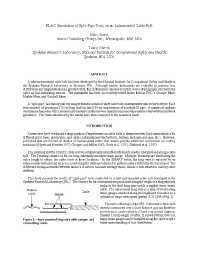Mining Publication: FLAC Simulation of Split-Pipe Tests on an Instrumented Cable Bolt
Original creation date: April 2002
A new instrumented cable bolt has been developed by the National Institute for Occupational Safety and Health at the Spokane Research Laboratory in Spokane, WA. Although various instruments are available to measure load distribution and magnitude along a grouted cable, this instrument is innovative in that it uses strain gauges internal to the cable as load-measuring sensors. The instrument has been successfully tested in the field at FMC's Granger Mine, Meikle Mine, and Getchell Mine. A "split-pipe" laboratory pull test was performed on each of three cable bolts instrumented with the new device. Each test consisted of grouting a 1.83-m-long cable in two 0.91-m-long sections of schedule 80 pipe. A numerical analysis was then performed in which laboratory boundary conditions were simulated and model properties derived from textbook guidelines. The loads calculated by the model were then compared to the measured loads.
Authors: M Ruest, LA Martin
Conference Paper - April 2002
Canadian Institute of Mining Annual Conference, Vancouver, BC, 2002 Apr; :9 pp
See Also
- A Case Study of Bolt Performance in a Two-entry Gate Road
- Determination of Physical Properties of Cable Bolts in Cement Grout Pull Tests Using Instrumented King Wires
- Evaluating Factors Affecting the Performance of Three-Axis Ultrasonic Anemometers
- Evaluation of Instrumented Cable and Rebar Bolts as Ground Support at a Trona Mine
- Evaluation of Instrumented Cable Bolts in Cement Grout to Determine Physical and Numerical Modeling Properties
- Experimental Mine and Laboratory Dust Explosion Research at NIOSH
- Field Tests of Cable Bolts Using Instrumented King Wires
- Performance of a New Personal Respirable Dust Monitor for Mine Use
- Technology News 476 - Instrumented King Wire for Monitoring Cable Bolts
- Updating the NIOSH Support Technology Optimization Program (STOP) With New Support Technologies and Additional Design Features
- Page last reviewed: 6/29/2015
- Page last updated: 6/29/2015
- Content source: National Institute for Occupational Safety and Health, Mining Program


 ShareCompartir
ShareCompartir
